Our favorite time of the week is Million Dollar Case Study time – and this week we kicked off the second session of the Europe edition of the case study, with some advanced product research tactics to find private label product ideas.
Phew! Since last week it’s been a whirlwind of doing my product research that I had some great guidance from Greg for in last week’s session, as well as putting together all of my thoughts to share with you guys.
I spent about three hours poring over the Web App and browsing Amazon.co.uk to find a list of product ideas (which I will share with you shortly). The main thing that stood out to me was that, although it is time consuming, it’s definitely something you can do alongside your full-time job or other commitments. If you just dedicate 1 hour a day every other day, you will have a list of up to 50 ideas within a week! How cool is that?
In this weeks session we cover:
- How to critically assess your list of product ideas and narrow them down to a shorter list of viable products
- Advanced product research tactics to define market depth and trends, product details and the competitor landscape
- Your homework: to follow in our footsteps and reduce your own list of ideas to the top 3-5 for next weeks session
And this weeks slides:
What We’re All Here For
Greg started the Million Dollar Case Study primarily to help people unlock their potential and build their own lifestyle by documenting a proven blueprint to building your own business and growing it successfully. Additionally, we are donating all of the profits of this case study to Pencils of Promise and are aiming to help build 5 schools around the world with the donations!
You have a chance to get involved too – first of all by participating each week, asking us questions and most importantly, following along in real-time to launch your own successful product on Amazon.
Here’s an inspirational story from our recent giveaway winner, Keoki:
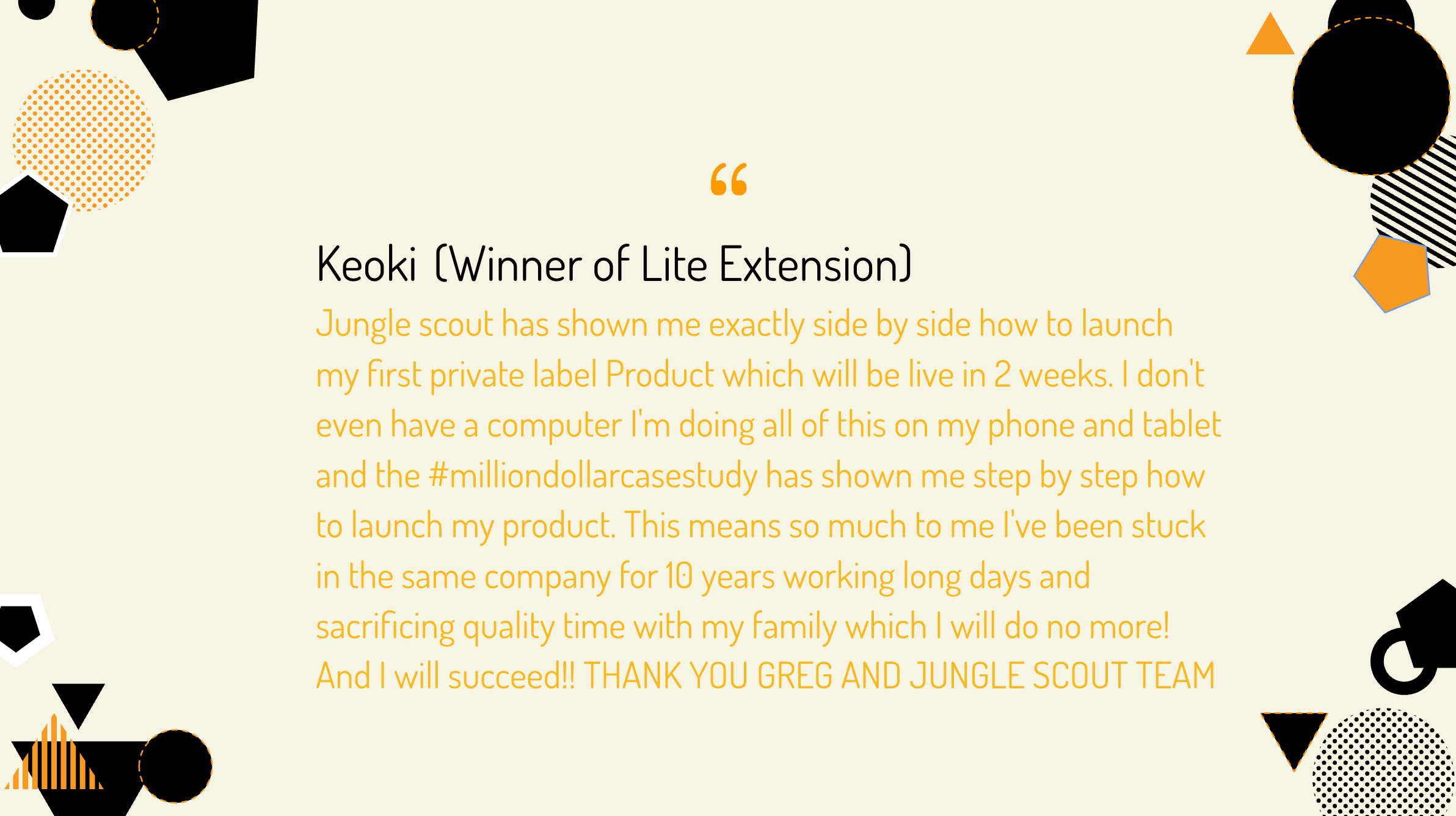
That’s all the motivation I need to inspire me to dive into my advanced product research! Let’s begin…
I have a list of product ideas… what’s next?
Last week we ran through the “basic” (read: super important) product research criteria. This was the top level stuff that you need to be thinking about constantly when building a larger list of product ideas. These criteria were:
Must have:
- Existing Solid Demand
- Low Competition
- Good Margins
- No Legal Issues
Nice to have:
- Small/lightweight
- Easy to source and ship
- Able to improve
- Low Seasonality
Depending on which marketplace you are researching, the level of demand and competition you are looking at will vary. If you need to recap, we have covered this for the US marketplace here and Europe here!
My List Of Private Label Product Ideas For The UK
With Greg’s words of wisdom, I went and did my own research using these criteria alone, and curated a list of 43 product ideas for Amazon UK. Here’s a list of those ideas, all of which have varying levels of demand and competition:
| Main Keyword | Category |
| Dog Rocks | Pet Supplies |
| ABS Hard Shell Suitcase Cabin Luggage | Luggage |
| Strong Cardboard Boxes | DIY & Tools |
| Clothing Rails | Home & Kitchen |
| Full Face Snorkel | Sports & Outdoors |
| Double Skin Dome Tents | Sports & Outdoors |
| Milk Steamer | Home & Kitchen |
| Kids Scooters | Toys & Games |
| Wireless Meat Thermometer | Home & Kitchen |
| Automatic Pet Feeders | Pet Supplies |
| Sleep White Noise Machine | Health & Personal Care |
| Foldable Travel Cot Mattress | Baby Products |
| BBQ cover | Garden & Outdoor |
| Jam Jars (bundle) | Home & Kitchen |
| Giant Pool Floats | Toys & Games |
| Glass Water Bottle | Home & Kitchen |
| Vacuum Water Bottle | Home & Kitchen |
| Baby Sling Wrap | Baby Products |
| Maternity Pillow | Baby Products |
| Cotton Crib Sheets | Baby Products |
| Baby Cutlery | Baby Products |
| Garage storage shelving | Home & Kitchen / DIY Tools |
| Metallic Plastic Cutlery | Home & Kitchen |
| Abs Trainer | Sports & Outdoors |
| Garden Waste Bags | Garden & Outdoor |
| Giant Tumble Tower (Jenga) | Toys & Games |
| Glass Food Storage | Home & Kitchen |
| Oil Diffuser | Home & Kitchen |
| Inflatable Lounger | Sports & Outdoors |
| LED spa light | Garden & Outdoor |
| Key Safe Box | DIY & Tools |
| Sleeping Bags | Sports & Outdoors |
| Shower Organiser | Home & Kitchen |
| Bathtub Caddy | Home & Kitchen or Beauty |
| Silicone Cooking Utensil Set | Home & Kitchen |
| Folding Camping Bed | Sports & Outdoors |
| Cotton Baby Muslins | Baby Products |
| Travel Pillow | Home & Kitchen |
| Bath Pillow | Beauty |
| Solar Garden Lights | Home & Garden |
| Waterproof Picnic Blanket | Garden & Outdoor |
| Yoga Mat | Sports & Outdoors |
| Badminton Nets | Sports & Outdoors |
Hopefully, if you tuned in last week, you did the same and have a similar list of ideas? I would love to hear more about what you found in the comments!
Picking Out Your Top Ideas
Prior to this weeks session, I started to narrow this list down to my top five product ideas, which I wanted to bring to the table this week to discuss with Greg and get his expert opinions.
The top 5 I picked out are highlighted in the list above, and this was very strongly based on the level of existing demand and the top-level view of how competitive these products may be.
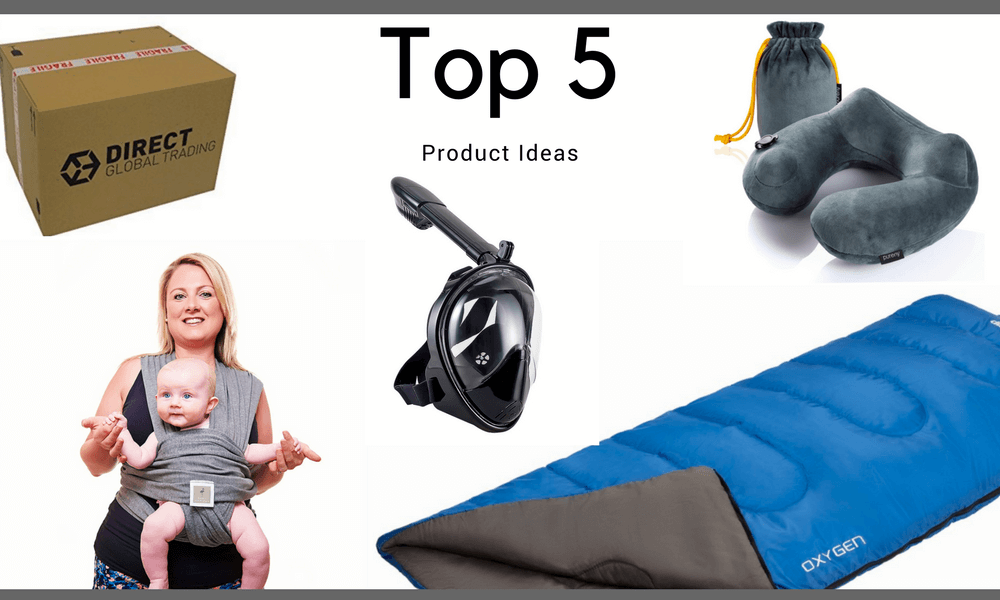
Other things I was already thinking about include:
- Will it have low seasonality
- Is it easy to manufacture
- Will it be profitable
Now, a lot of this boils down to my own intuition and from listening to Greg’s advice in the last session. I don’t actually know for sure how much these products would cost to manufacture and I need to find out more about the seasonality.
This is exactly where the advanced product research comes in. We need to take a much deeper look at our top products. I am using 5 as an example, but if you wanted to spend more time and investigate more than 5 products in more detail, that’s cool too.
Advanced Product Research Tactics
There are a whole host of things to consider to weigh in on which product would be the best one to launch! Greg went over some of these in the slides before he took a look at my top 5 products. Here’s the advanced criteria that you need to be investigating for your top product ideas:
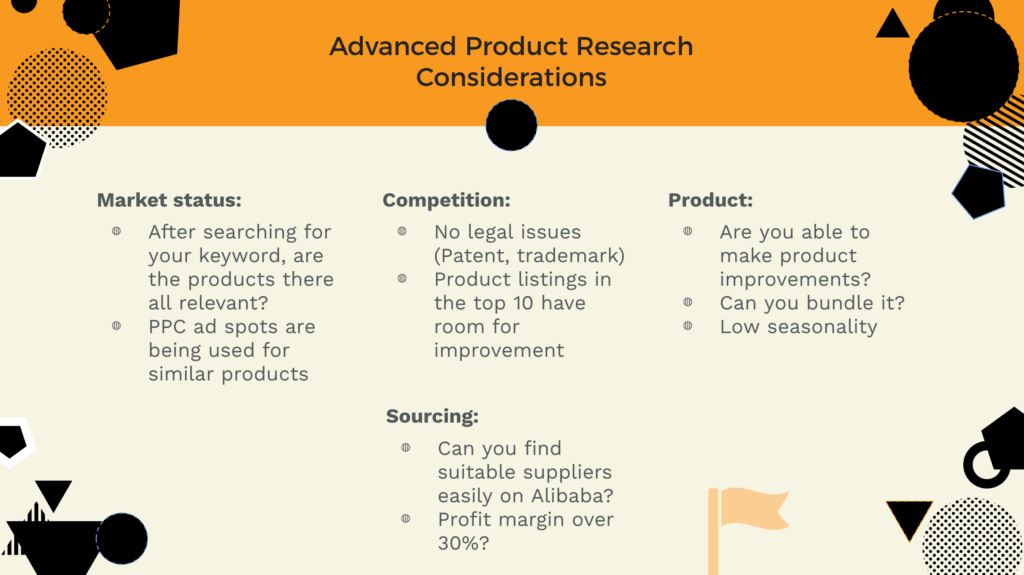
Here’s a breakdown of this and how you can start researching each topic:
Keyword relevancy
do a quick search on Amazon for your top keywords. If the first couple of pages have products that aren’t the product you are looking to sell then this can be a good sign and indicate lower competition
PPC ad spots used?
it’s a good sign of demand if the top keywords are bringing up the product idea that you are looking to sell. Plus you can also gauge the competition levels by doing this quick check.
Legal Issues
If a product looks like it might be a unique design, or even if it doesn’t, it’s always worth double and triple checking you won’t infringe on any intellectual property by launching this product. I found a few useful UK websites when doing my research, including a European IPO search website and the UK government website for information about patents.
Of course, at this point, you just want to do as much research as you can. Later on, you might need to seek legal advice if you are unsure if a product would have any legal issues.
How strong are competitor listings?
The Jungle Scout Web App database shows a listing quality score out of 100 (LQS) which is our own proprietary scoring system. Although this is a quick way to assess the competitor product listings, you can do this manually really easily. Here’s what you need to look out for in a poor listing:
- Only 1 to 3 images on the listing
- A title that is not explanatory and does not contain main keywords
- Less than 5 features (bullet points)
- A short, poorly written and unformatted product description
- Number of reviews
If you find that there are a few sellers with poor listings, and especially if those sellers are still making sales each month, then you know you have something that you can improve on right away (because we are going to cover how to create the best listing ever, of course!). If you see a lot of high quality listings, then you might find that the competition is a little higher, or that you need to find other ways to differentiate… see next point.
Can the product be improved?
A really simple way to find out if you could source and manufacture a better version of a product is to read customer reviews for all other sellers of this product. Take a look at what people are unhappy about and figure out if you can improve that. We did this with Jungle Snugs, by sourcing the thickest and snuggliest baby hooded towel, and we also made it larger in size so that it would be suitable for a longer period of the child’s growth.
Don’t forget to also take a look at the positive reviews to see what people like about a product to make sure you don’t miss any unique selling points!
Can you bundle it?
This is a really easy way to improve a product. Take a look to see if other sellers are already doing this. If not, get creative. What could you add? Using Jungle Snugs as an example again, we added a free bonus washcloth using the off cut material. So it didn’t cost us any more and it makes our customers really happy. Win win!
There’s an endless list of things you could bundle with a product, whether it’s a free case, a low cost item that makes for a nice addition, or even a free guide that becomes a lifestyle addition
Is seasonality low?
You can usually guess which products are going to have high seasonality. By this I mean products that only sell well at certain times of the year. Even though your gut instinct is probably right, make sure you head to Google Trends (you can access this directly from the Jungle Scout Chrome Extension), and double check. Trends will show you when people are searching for keywords related to your product idea, so you can quickly assess if there are huge spikes at certain times, like the holiday season.
Are there plenty of suppliers on Alibaba?
Especially if you are a new seller, you may not have any experience of sourcing and manufacturing capabilities in China. The quickest way to ease your fears is to head to Alibaba and search for your product idea. You will very quickly be able to see at a top level if there are plenty of suppliers that specialize in your product, or the components that make a product.
Is it profitable?
Saving the best until last here. Once you have been through all of the above and you still think “yep, this is a kick-butt product idea”, you need to start investigating if it is going to be profitable. Being as you have just been searching for suppliers on Alibaba, you will also notice that you can see some estimated cost prices right on the search results:
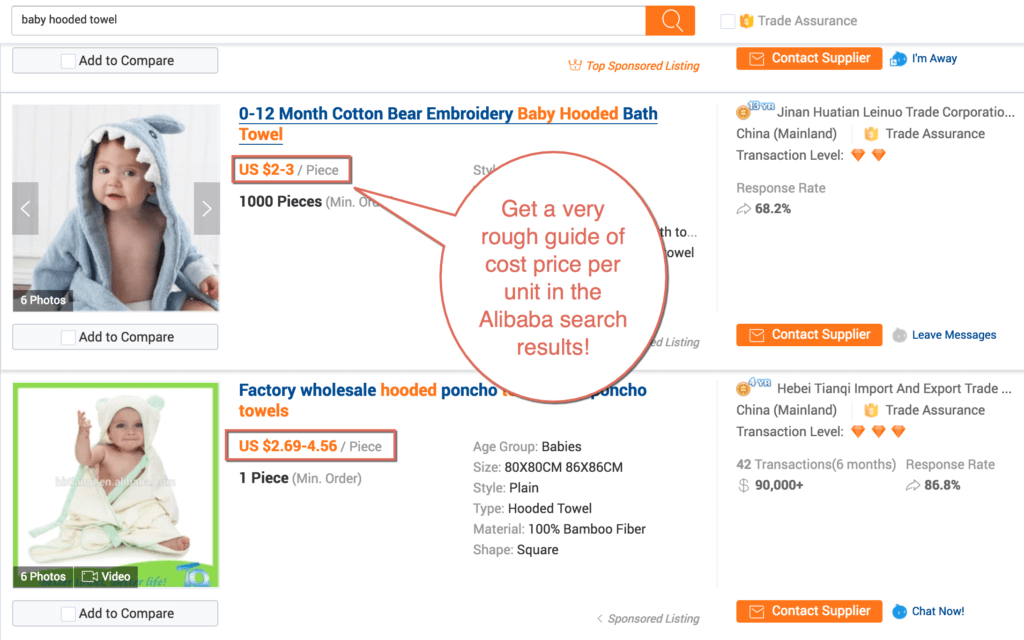
Greg advised me to take this with a very fine grain of salt, but it is a good top-level indicator of how much the product would cost to manufacture. From there you can take a look at your Net (price minus FBA fees) and calculate some rough profit margins.
For example, if a product cost $10 to manufacture per unit, and your Net was $20, then you would have $10 profit.
Real Life Examples: Greg Reviews My Product Ideas
Although all of those things above seem like a lot, it really is worth spending the time assessing all of the products you are considering investing in. This ensures you are exploring all avenues and making sure your final decision is one that you are confident in, and that suits you and your future business.
Greg shared his thoughts on my top 5 products as follows.
- Cardboard boxes – Greg thought this was an interesting idea and liked the high demand but was unsure about whether this would be a good item to get manufactured in China. He mentioned that you may actually be able to source this type of product in the country you want to sell it in, but that’s not something he has experience with. Therefore, this is one idea where research into suppliers and shipping would be very important. (I was making notes for my homework, your homework is coming up very soon).
- Full face snorkel – This is a really hot product right now, and they are pretty unique. Greg liked this and the fact that the demand was high. His two initial thoughts were: would there be any legal issues and is their seasonality. In terms of legal issues, because it’s such a unique product, there may be an existing patent or even a patent pending. However, Greg felt some comfort in the fact that there were lots of other FBA sellers making money from this product. So legal issues, definitely one to look into.In terms of seasonality, it looked like there were two spikes, one around the December holiday period and one in July. Greg didn’t seem too worried about this, though. This would be a medium level of seasonality and it’s not a total deal breaker.
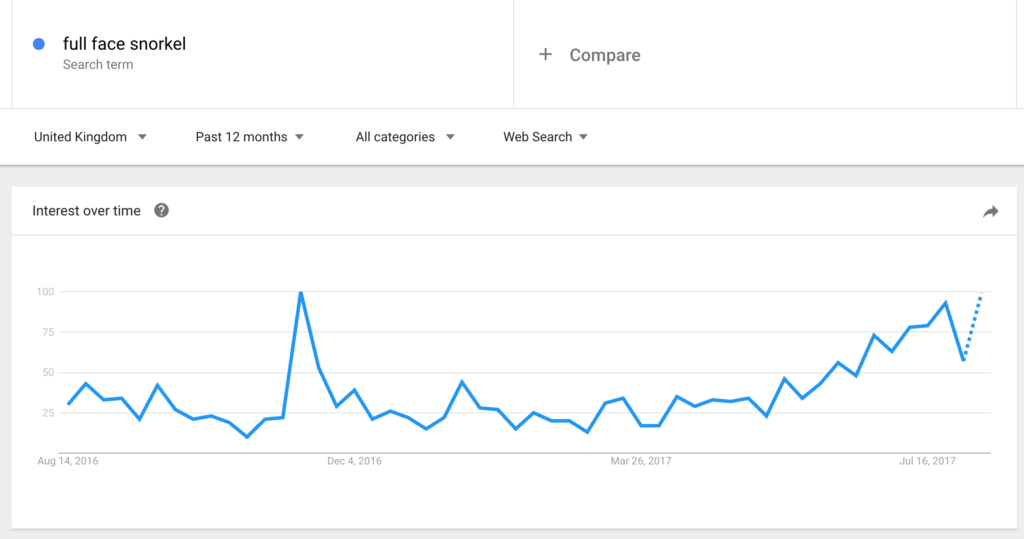
- Baby sling – This product is essentially a large piece of fabric that sells for quite a high price (£20 and over). Greg mentioned that this would mean high-profit margins which is great news. The demand wasn’t as high for this product as the others but it seemed like it would be a good product to market. Greg’s views were that price is not always about the cost of manufacture. In this example, it may be that a parent would be willing to pay more money for a baby sling that is stronger and guaranteed to keep their baby safe, whilst also making them look good wearing it. Wise words on product marketing!
- Sleeping bag – This product has high demand and quite high competition, but when Greg took a look, he could see that the sales were spread out across the top 10 sellers and beyond. Therefore the depth of market is sufficient. Though this is quite a competitive product, for the purposes of this case study we would feel comfortable launching this product. Greg mentions that if you were a new seller and this was your first investment, then you may pick a less competitive item to start out with! I had a concern in that I could see a fairly well known UK brick-and-mortar retailer selling sleeping bags in the top 10. Again, for Greg this was not a deal breaker. The thing that he would look out for is “do the consumers care?”. Because of the depth of market with this product, it seems that consumers aren’t brand aware when purchasing sleeping bags on Amazon.Conversely, if you see a product where one seller is killing it and everyone else is trailing behind, then you should be seeing red flags.
- Travel pillow – Again this item has strong demand and mid-level competition, but Greg liked it because it is one that could easily be bundled. Think eye masks, ear plugs, free carry case. Another fabric product too, so we should be able to see strong profit margins from this. Greg also took a look at some of the existing sellers and saw some poorly put together product listings, so that looked promising too.
Session #2 Homework
You knew it was coming – it’s time to do your homework alongside me. Together we can use Greg’s advice and ideas that he shared in this session to do further research covering all of these advanced criteria. I’ve put together a template that you can use to keep a note of your findings for your top products which you can download here!
Remember, the point of this case study is to help guide to find your own opportunities, not just use exactly what we are doing. So just add your own list of ideas into this spreadsheet, and all of the relevant information for your product:
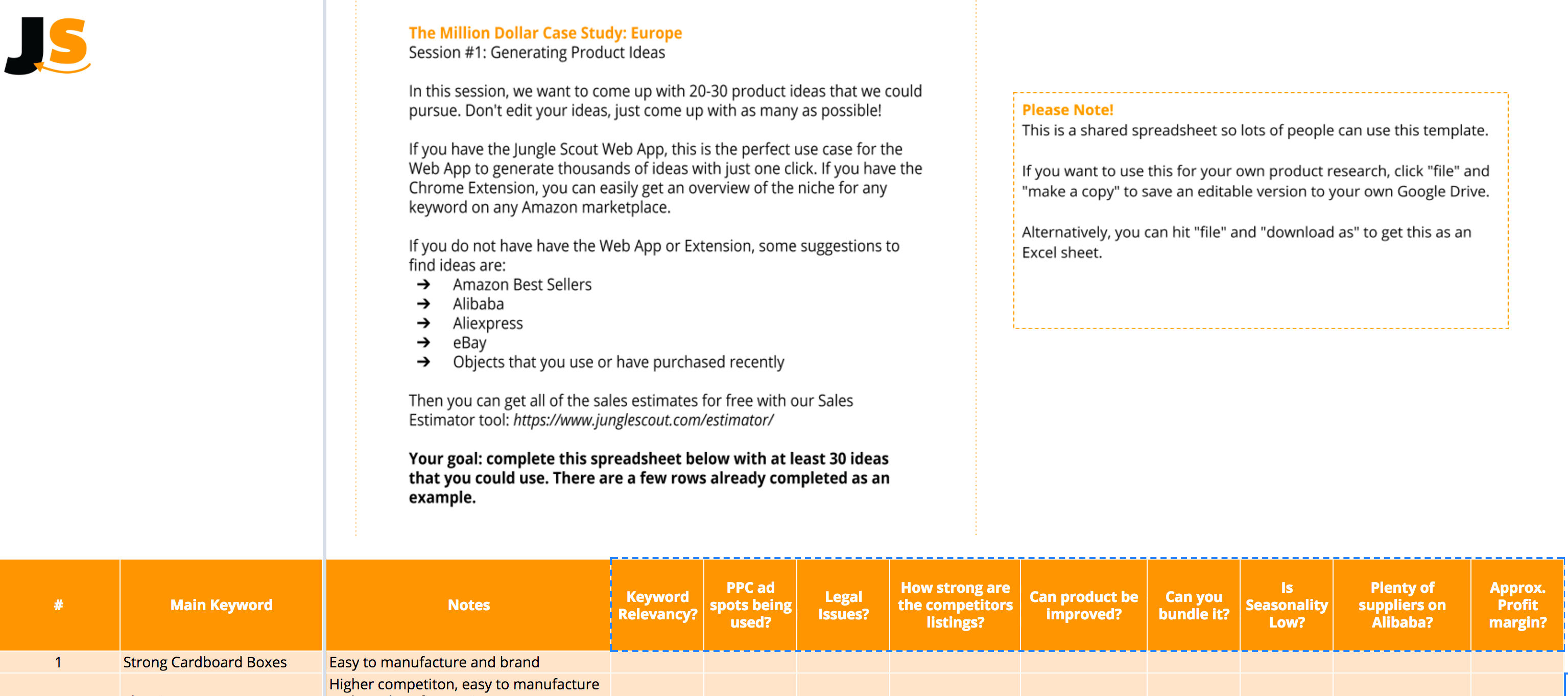
You can also use these tactics and this same spreadsheet to find product ideas in any Amazon marketplace, not just the UK. Make it work for you 👌
Conclusion
It’s going to be a tough call, I really like all five of my product ideas. But I need to let my research, and most importantly the data, determine my final decision.
Spending your time on product research is wise because it’s going to be your investment in your future. Following these guidelines helps to minimize risk and maximize the chances of success!
Next time…
Since this session, I have been busy doing my homework and I created a vlog to share some of my findings with you ahead of session #3, check it out:
Before I decided on my product, I started out with some supplier outreach to double check that I could find a reliable supplier and pick a product that is going to be most profitable. Find out exactly how I did that in Session #3.
If you are following along after the live case study has taken place, my advice is to stay on track and complete your homework each week for a full step-by-step intro to selling on Amazon. You can find all of the available session recaps here.
Subscribe on YouTube for the latest informational content on all things Amazon & ecommerce:

 25 Comments
25 Comments
25 comments on “The Million Dollar Case Study: Europe – Session #2: Advanced Product Research”